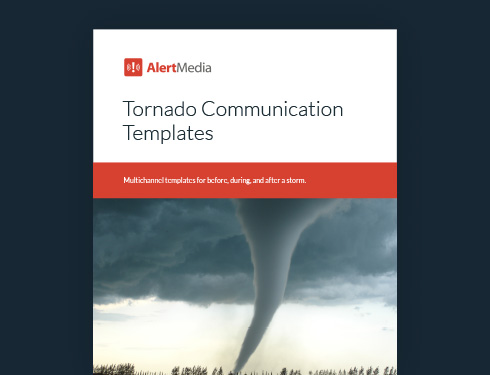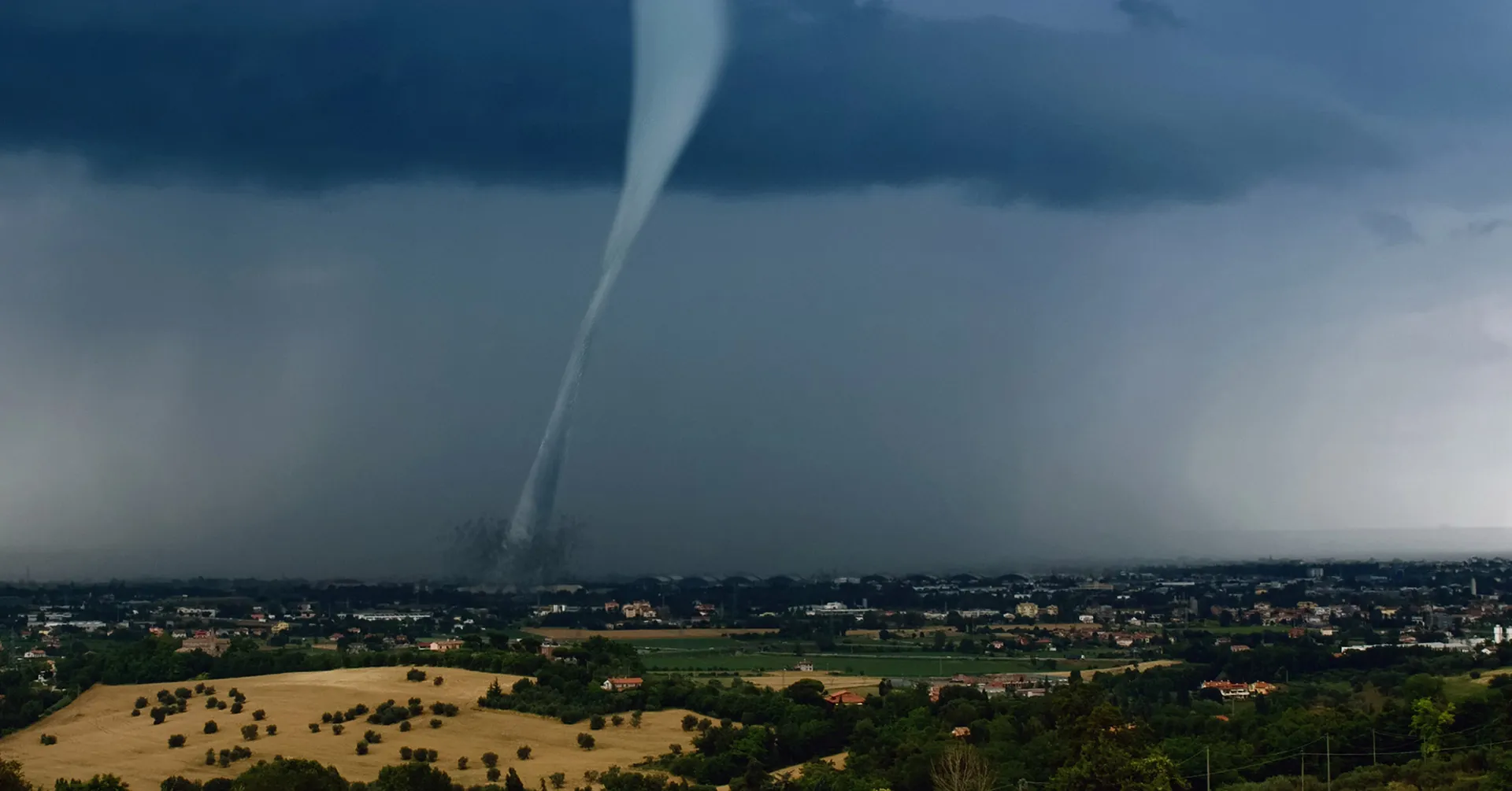
Tornado Preparedness for Business: Plan, Practice, Communicate
Tornadoes are dangerous and in some cases very common, and you can’t leave your employees hanging in the wind. Here’s how to make sure your business and people can stay safe during a tornado.

In 2011 a massive outbreak of tornadoes descended upon a huge swath of the United States, from Texas all the way to southern Canada. At least 360 tornadoes were confirmed in only four days and quickly turned out to be the costliest and deadliest tornado outbreak in history.
On The Employee Safety Podcast, host Peter Steinfeld asks guest and National Weather Service meteorologist John de Block if the 2011 outbreak was a “once in 100 or 500 years” event. Unfortunately, John said, such extreme tornado events happen every 35-40 years, meaning that people and businesses should actively prepare for similar events in the future. Already tornadoes have caused significant damage in 2023, the first quarter of which saw a record number of tornadoes, heralding a potentially active tornado season. There’s no better time to prepare than now.
Tornadoes may be unpredictable, but your response doesn’t have to be. With a tornado preparedness plan and early tornado drills, your employees will know how to stay safe during a storm and you’ll be able to recover from any damage and return to business as usual in no time. Keep reading to learn how to build your own preparedness plan to protect your people and operations when a tornado happens.
Understanding Risk and Tornado Hazards
One big challenge is that tornadoes can occur with little notice, and risk levels vary depending on the region, working conditions, and facility features (i.e., those with access to a sturdy building, storm cellar, or safe room will experience a tornado differently than those working outdoors).
For businesses in areas at high risk of tornado activity, the first step is to understand the potential risks. Consider the different types of tornado hazards, such as strong winds, flying debris, and downed power lines that can damage property, buildings, and infrastructure. Also, think about how such conditions can affect people both inside and outside of buildings in terms of physical harm or psychological trauma. This kind of information will be important for preparing effective emergency plans tailored to your organization’s unique needs.
Tornado Communication Templates
Conduct a Risk Assessment
To create an effective tornado preparedness plan, you need to evaluate how at-risk your facility, people, and operations are. Think about where your employees and facilities are located and walk through your entire building and grounds to note any potential hazards or vulnerabilities. Consider things like:
- Your geographic location and average tornado frequency.
- The construction of your building. Metal or reinforced concrete buildings offer more protection than wood or brick. When assessing safe spaces for shelter, look for load-bearing walls and avoid areas with windows.
- The location of critical infrastructure, such as generators, server rooms, and utility shutoffs. These areas will need extra precautions in an emergency.
- Outdoor areas where people congregate, including smoking areas, loading docks, and parking lots. Employees will need advance warning to get inside quickly.
- Potential hazards like nearby power lines, trees, or loose debris that could fall or become airborne during high winds. Trim or remove them if possible.
- How you communicate with employees, clients, and others who are onsite, as well as those who are remote or traveling.
Once you’ve assessed the risks, you can determine the best way to mitigate them and build those steps into your preparedness plan. You may need to make facility improvements, stock emergency supplies, or relocate critical operations. But knowing where your vulnerabilities lie is the first step to gaining control over them.
Conducting a risk assessment will give you essential information to craft an effective tornado response plan tailored to your company’s unique situation. Your employees’ safety depends on it, so make this a priority in your emergency preparedness efforts. When severe weather threatens, you’ll be glad you took into account all vulnerabilities and preparedness opportunities.
Develop Your Emergency Plan
Once you have a risk assessment, it’s time to create your emergency plan.
Work with your team to determine how to respond to different types of tornadoes in your area. Outline specific steps to take for warnings and actual tornadoes. An effective plan should include
- Emergency communication procedures: Have systems in place to quickly alert all staff about an approaching tornado and provide instructions. Things like mass notification systems, intercoms, and emergency alert radios are must-haves.
- Shelter locations: Identify the safest areas for people to gather, like interior hallways, stairwells, or rooms away from exterior walls and windows.
- Routes to safety: Map out the fastest ways for people to get to the shelter locations from all areas of the building. Practice and physically walk through these routes.
- Securing vital resources: Develop procedures to properly secure or relocate critical infrastructure, data, equipment, and inventory to minimize damage.
- Recovery plan: Outline how you will account for all employees, assess damage, and restore operations after a tornado hits. Planning for recovery in advance will help minimize downtime.
Assign Roles and Responsibilities to Your Team
Once you have a tornado preparedness plan in place, you can assign roles and responsibilities to your team members.
Determine who will lead your emergency response and who will fill other critical roles. You’ll want a primary emergency coordinator and backup, as well as leaders for communications, facilities, security, and employee welfare.
Emergency CoordinatorThe emergency coordinator takes charge when a tornado is incoming. They’re familiar with the plan and the people involved with it and use that knowledge to make sure the whole process runs as smoothly as possible. |
Communications LeadThis person will be in charge of monitoring weather alerts, notifying employees if evacuation or sheltering is necessary, and keeping in contact with local emergency management officials. They should have a backup and be skilled in using your emergency notification system, as well as training other employees to use it. |
Facilities LeadThe facilities lead will oversee preparing the building by securing outdoor objects, closing windows and exterior doors, and turning off utilities if needed. They are also responsible for damage assessment and restoration of utilities after a tornado. |
Security LeadYour security lead will direct employees to shelter areas or evacuation routes and control access to the building. They will also sweep the building after a tornado to ensure all employees have evacuated, if necessary, before allowing re-entry. |
Employee Welfare LeadThis role focuses on assisting any employees with disabilities or access and functional needs, providing basic first aid, and keeping track of all employees during and after an emergency. They should have CPR and first aid training and usually come from the HR department. |
By assigning these key roles in your tornado preparedness plan, you’ll have the right people in place to take action quickly if a tornado threatens your area. Be sure each role has a primary lead and at least one backup and that all employees understand their own responsibilities, as well as how to follow instructions in an emergency. With a solid plan and team in place, you’ll have the best chance of protecting your people and operations.
Proactive Communication Is Key
When severe weather threatens, communication is critical to keeping everyone safe. Make sure you have a communication plan and an emergency communication system in place to handle different scenarios.
- Make sure your communications lead has the training and support to spread critical messages
- Have a plan to quickly alert all employees to take shelter or evacuate via all communication channels—in case one method fails. This could include:
- An intercom or PA system
- Text message alerts
- Email alerts
- Word-of-mouth (instruct floor wardens and team leaders to spread the word)
- Prepare template messages ahead of time for different emergency scenarios. This will make it faster to communicate in the moment.
- Use a radio to track weather updates from the National Weather Service (NWS) and National Oceanic and Atmospheric Administration (NOAA).
Tornado WatchTornado watches are advisories that indicate favorable conditions for tornado formation, but there is no certainty that a tornado will form. | Tornado WarningTornado warnings are issued when there is credible evidence that a tornado has already formed in the area due to a sighting or radar detection. |
Once a warning has been issued, continue providing regular updates to keep everyone informed. Let employees know:
- Where the tornado has been spotted and its projected path
- When to take shelter or evacuate
- Where the designated shelter areas are located
- When the warning has been lifted and it is safe to return to work areas
Effective communication and providing frequent updates will help keep all staff safe in an emergency situation. Be sure to practice your communication plan along with the rest of your tornado preparedness plan. Make any necessary improvements to ensure messages are received and understood quickly when it really counts.
Educate Employees and Practice the Plan
Ensure employees know what to do if a tornado strikes. They need to be able to recognize warning signs of an oncoming storm and know how to prepare. Cover the following:
Share the plan
Everyone in your organization should be aware of the specific steps that need to be taken in case of a tornado. Ensure the emergency plan is documented and accessible. Review all aspects of the plan with employees, including routes to shelter areas, and allow for questions and clarification.
Teach the warning signs of a tornado
Tornadoes usually come with warning signs, including weather conditions like thunderstorms, hail, whistling winds, dark clouds, and sudden changes in wind speed or direction. Make sure everyone knows what these signs are, so they feel confident to take action right away if they see them.
Review the safe shelter spots
Be sure your employees know where they should go during a tornado—a safe place with no windows near the center of the building or lowest level. It isn’t always possible to install a tornado shelter or storm shelter—especially one that would fit all employees. A basement works great, but if you don’t have one, head to an interior room on the lowest floor possible and crouch down against the wall away from windows or glass doors.
Outline the necessary supplies
In the event of a tornado, it’s crucial that everyone has access to emergency supplies. For example, flashlights and backup batteries are essential as power outages are common during severe weather. Other necessary supplies include first aid kits, bottled water, non-perishable food items, and a battery-powered radio to stay updated on the latest news and weather reports (NOAA Weather Radio and social media accounts from local authorities are great resources for this).
Individuals should keep a stash handy of appropriately sized gloves, sturdy shoes, and other protective gear to assist with post-tornado evacuation cleanup efforts.
Make sure your employees are familiar with the location of emergency supplies, and periodically check the items to ensure they’re in working order.
Practice the response plans and test for weaknesses
Conduct regular emergency drills to test your business’s readiness. Schedule both announced and unannounced drills to prepare employees for real events. Debrief after each drill to identify areas for improvement. If you don’t give everyone in your organization practice drills, they won’t know how to respond if a real emergency happens.
Some tips to keep in mind when conducting drills:
- Make sure the drill feels realistic so that your employees are prepared for any eventuality—including sounding a warning system alarm or having a spokesperson explain instructions over a loudspeaker.
- Assign roles to oversee the drill: a drill coordinator and an observer (or multiple observers) who monitors employee compliance with safety procedures.
- After the drill, review how it went and document observations. Talk to employees about their experience and review data from any alerts sent during the drill. With this information, you can identify areas for improvement.
Emergency communication systems can help streamline the process by making it easy to send notifications or alerts to staff when drills occur or if significant weather is expected. The best kind of emergency communication systems are multichannel with two-way communication capabilities, so you can hear back from your employees if they need assistance during an actual tornado.
Adjust Plans for Remote Teams and Remote Working Locations
If your business employs remote workers or has multiple locations, you’ll need to make sure your plans cover everybody. Companies should consider implementing an emergency communication system that allows them to quickly alert employees and update them on the latest safety measures.
One of the best ways to help protect all employees—whether onsite, remote, or traveling—during a tornado is by establishing a plan that keeps everyone informed and updated without worrying about people not being in one physical space:
- Set up an integrated threat intelligence and emergency alert system so people can be warned quickly through pop-up notifications, SMS text messages, or automated emails.
- Schedule regular group check-ins with the remote team members over video conference or phone calls so everyone remains connected and informed.
- Encourage employees to use the alert system for up-to-date weather information about their current location as well as any potential storm paths or threat zones that may be nearby.
- Train employees on how to respond and what safety protocols to follow if a tornado warning is issued near their location.
- Have plans in case of power outages, so remote workers can remain connected and stay safe if they are unable to access any online resources
Hope for the Best, Prepare for the Worst
Creating a comprehensive preparedness plan will take some work, but it’s worth the investment to ensure the safety of your people and the continuity of your operations. Once you assess the risks, assign responsibilities, and establish emergency communication protocols, you’ll have peace of mind knowing you did everything within your control to shield against these powerful storms. Tornadoes can be terrifying, but by planning ahead, you’ll be ready to take action right away and get everyone to safety quickly. Stay alert this season, get your plan in place, and practice drills to keep your skills sharp. You’ve got this! With the right preparation, you can weather any storm.



![9 Steps to Creating an Effective Emergency Response Plan [+ Template]](https://www.alertmedia.com/wp-content/uploads/2023/10/Blog-Emergency-Response-Plan.webp)
